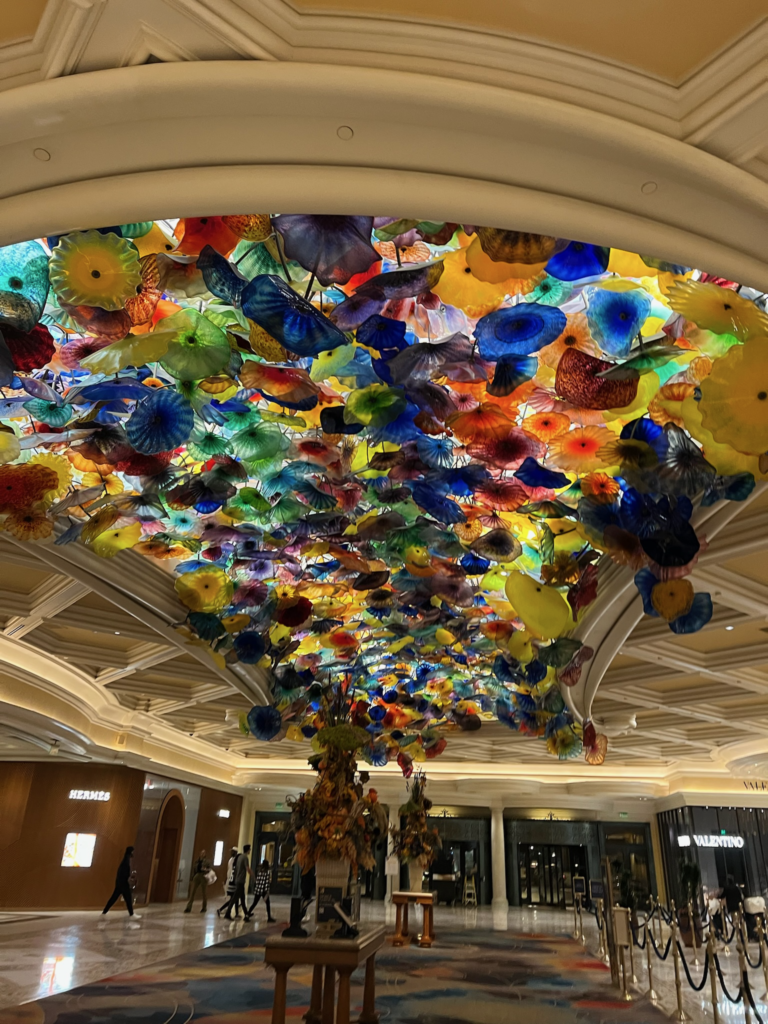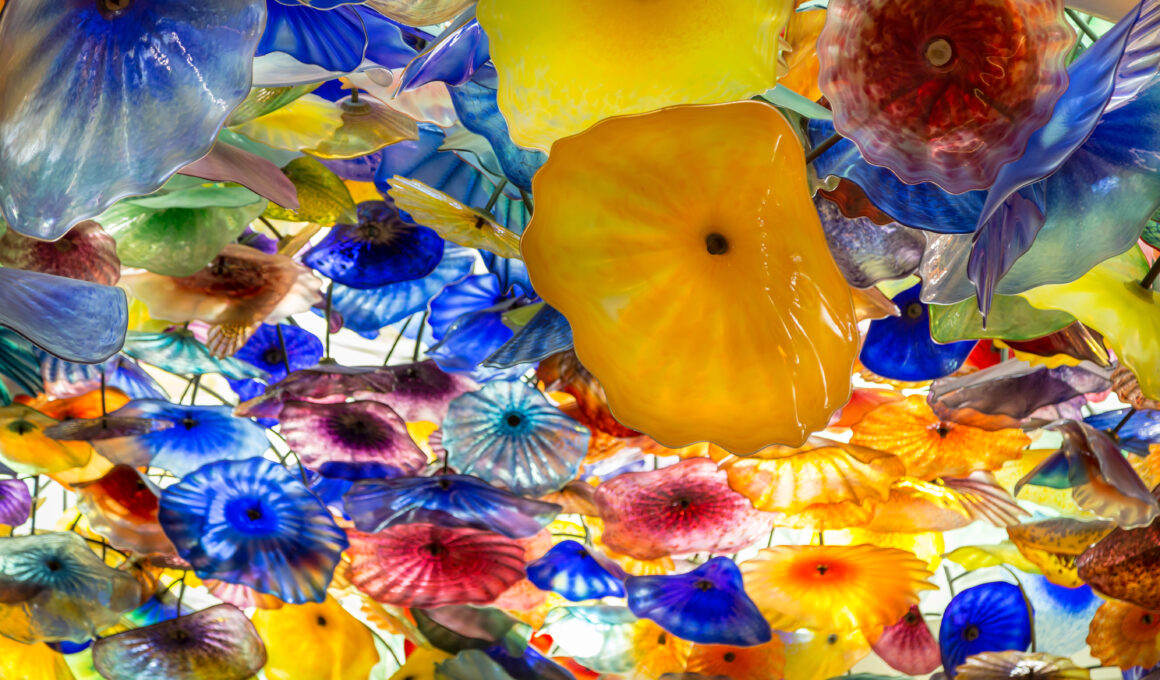Las Vegas art often hides in plain sight, a city synonymous with dazzling lights, high-stakes entertainment, and opulent luxury that surprises visitors with its burgeoning creative scene. Beyond the slot machines, showgirls, and sprawling casino floors, a curated world of fine art flourishes within the walls of its most prestigious hotels. These establishments aren’t just places to sleep—they’ve evolved into cultural hubs, offering immersive artistic experiences that rival standalone galleries. This article explores the unexpected art havens nestled in the Bellagio, Aria, and The Cosmopolitan, with a special look at the Bellagio’s lobby art, revealing how these luxury settings blend cultural enrichment with the electric pulse of Las Vegas.
Bellagio: A Symphony of Elegance and Art
The Bellagio stands as a beacon of sophistication on the Las Vegas Strip, its iconic dancing fountains a prelude to the artistry within. The Bellagio Gallery of Fine Art, a dedicated space since 1998, anchors its cultural offerings with rotating exhibitions that have showcased masterpieces by luminaries like Claude Monet, Pablo Picasso, and Andy Warhol. Past shows, such as “Monet: Masterworks from the Museum of Fine Arts, Boston” in 2001 or “Warhol Out West” in 2015, have drawn art lovers into a 1,200-square-foot oasis of calm amid the casino’s clamor. Each exhibition is a meticulously curated journey, with works hung against neutral walls, illuminated by soft lighting, and paired with placards that weave historical narratives—think Monet’s impressionist brushstrokes or Picasso’s cubist deconstructions.
This gallery isn’t static. Its ever-changing lineup ensures repeat visitors encounter fresh perspectives, from “American Modernism” in 2019, featuring Georgia O’Keeffe, to “Fabergé: The Imperial Eggs” in 2023, spotlighting Russian craftsmanship. Tickets, priced around $18, grant access to a space where silence reigns, offering a stark contrast to the slot machines just steps away. The Bellagio’s curators aim to educate as much as entertain, bridging centuries and styles to spark contemplation in a city often pegged as fleeting.
Beyond the gallery, the Bellagio’s lobby itself is a canvas of artistic wonder, headlined by Dale Chihuly’s “Fiori di Como.” Installed in 1998, this sprawling glass sculpture spans 2,000 square feet across the ceiling, a kaleidoscope of 2,000 hand-blown flowers in vibrant hues—reds, blues, yellows—suspended above the check-in desks. Chihuly, a titan of contemporary glass art, spent two years crafting this $10 million commission, blending organic forms with Vegas’s penchant for excess. Weighing 40,000 pounds, it’s supported by a steel frame, a marvel of engineering as much as aesthetics. Guests crane their necks to take it in, often snapping photos as petals seem to float midair, refracting light into a dreamy glow.
The lobby extends its artistic reach with seasonal displays at the Bellagio Conservatory & Botanical Gardens, adjacent to Chihuly’s masterpiece. This 14,000-square-foot space transforms quarterly, showcasing floral sculptures—think 20-foot cherry blossom trees in spring or a gingerbread village in winter—crafted by a team of 120 horticulturists. While not traditional “fine art,” these installations marry nature and creativity, drawing 5 million visitors annually. The Bellagio weaves these elements into its identity, proving art can elevate luxury beyond marble and gold.
Bellagio Art in the Lobby: A Deeper Dive
The Bellagio’s lobby art deserves a closer look, as it sets the tone for the hotel’s cultural commitment. “Fiori di Como” isn’t just decor—it’s a statement. Chihuly, inspired by Italian gardens and his Murano glassmaking roots, spent two years perfecting its 2,000 flowers, each blown by hand in his Tacoma studio. The installation’s scale—65 feet long, 30 feet wide—required a team of 100 to install over five days, a logistical feat that shut down the lobby in 1998. Its $10 million price tag, funded by then-owner Steve Wynn, reflects the Bellagio’s ambition to marry art with spectacle.
The sculpture’s impact is immediate. Guests entering from the Strip pass beneath its canopy, light filtering through glass petals to cast kaleidoscopic shadows on the marble floor. At night, it glows like a chandelier, its colors—amber, cobalt, emerald—dancing against the dark ceiling. Maintenance is meticulous: a crew cleans each piece annually, dangling from harnesses to preserve its luster. Chihuly himself has called it “a gift to Las Vegas,” a sentiment echoed by visitors who linger beneath it, awestruck.
The lobby extends its artistic narrative with smaller touches. Bronze statues of nymphs, cast in classical poses, flank the concierge desk, their patina a nod to European tradition. Rotating floral displays—orchids in summer, poinsettias in winter—complement Chihuly’s work, turning the space into a living gallery. This fusion of permanence and ephemerality makes the Bellagio’s lobby a microcosm of its broader art ethos, blending high craft with Vegas’s flair for the moment.

Aria: Contemporary Art as a Defining Feature
Aria Resort & Casino, opened in 2009 as part of the CityCenter complex, stakes its claim as a modern art powerhouse. Its public spaces brim with over 15 large-scale works, a $40 million collection curated to reflect its sleek, futuristic ethos. Unlike the Bellagio’s gallery focus, Aria scatters art throughout its 4 million square feet, turning lobbies, hallways, and plazas into a living exhibition.
James Turrell’s “Halo,” a standout in the lobby, greets guests with an ethereal light installation. Turrell, a pioneer of the Light and Space movement, uses recessed LEDs to bathe a curved wall in shifting colors—soft pinks fading to deep blues—creating a meditative pause amid Aria’s bustle. Commissioned for the hotel, it’s site-specific, its glow interacting with the glass-and-steel architecture designed by Pelli Clarke Pelli. Nearby, Jenny Holzer’s “Vegas Marquee” unfurls LED text across a 260-foot wall, streaming poetic musings like “Protect me from what I want,” a nod to Vegas’s temptations.
Sculpture dominates Aria’s collection too. Maya Lin’s “Silver River,” a 90-foot cast of the Colorado River in reclaimed silver, hangs above the registration desk, its shimmering curves evoking the West’s natural arteries. Tony Cragg’s “Bent of Mind,” a swirling bronze outside the entrance, twists upward like a frozen tornado, inviting touch and wonder. These works, part of a public art program mandated by CityCenter’s developers, integrate seamlessly with Aria’s minimalist design—open spaces, neutral tones, floor-to-ceiling windows—making art a core feature, not an afterthought.
Aria’s approach extends to its 4,000 rooms, where abstract prints and muted palettes echo the public art’s contemporary vibe. Guests encounter creativity at every turn, from Richard Long’s mud wall drawings in the spa to Nancy Rubins’ canoe cluster outside. This saturation transforms Aria into a gallery without walls, a space where luxury and innovation collide.
The Cosmopolitan: Art as an Experiential Journey
The Cosmopolitan of Las Vegas, opened in 2010, redefines hotel art with a bold, eclectic twist impenetrably woven into its identity. Its $15 million collection leans into interactivity and urban flair, reflecting the hotel’s hip, youthful energy. Here, art isn’t just seen—it’s felt, heard, and lived.
The lobby’s “Pillars”—eight 25-foot video columns—anchor this vision. Designed by Rockwell Group and Digital Kitchen, they display ever-shifting visuals, from abstract swirls to vintage Vegas footage, synced to ambient music. Motion sensors detect passersby, altering the imagery in real-time—step closer, and a cascade of petals might follow you. This dynamic interplay turns a check-in into a performance, drawing gasps and selfies from guests.
The Cosmopolitan embraces street art too. Murals by Shepard Fairey, whose “Obey” campaign redefined urban expression, splash across parking garage walls, their bold reds and blacks a gritty counterpoint to the hotel’s polished interior. Kenny Scharf’s psychedelic characters pop up in corridors, while RETNA’s calligraphic tags—commissioned in 2011—add a layer of mystery near the elevators. These works, often by rising talents, inject a raw, democratic spirit into the luxury setting, blurring lines between high art and street culture.
“Vegas is chaos and beauty—my art there screams to be heard above the noise.”
Shepard Fairey, on his Cosmopolitan mural in Artnet (2011)
Interactive pieces like Ivan Navarro’s “The End,” a neon-and-mirror sculpture spelling its title in infinite reflections, invite guests to peer into its depths, a metaphor for Vegas’s endless allure. The Cosmopolitan’s Art-o-Mat vending machines—refitted cigarette dispensers selling mini artworks for $5—add whimsy, letting visitors take home creations by local artists. This experiential ethos makes art a journey, not a static display, mirroring the hotel’s vibrant, unpredictable pulse.
The Cultural Experience Within Luxury Settings
These hotels transcend decoration, turning art into a cornerstone of their identity. The Bellagio’s gallery and lobby, Aria’s installations, and The Cosmopolitan’s digital experiments transform lobbies into exhibition halls, corridors into artistic pathways. They’re platforms for expression—Monet’s lilies, Turrell’s light, Fairey’s stencils—bridging continents and eras for a global audience.
This integration elevates luxury beyond material wealth. At the Bellagio, art offers serenity amid chaos; at Aria, it’s a bold statement of modernity; at The Cosmopolitan, it’s a playful dialogue with guests. Together, they prove culture and opulence can coexist, enriching the Vegas experience with depth. Guests find respite—pausing under “Fiori di Como” or tracing “Silver River”—moments of reflection in a city of excess.
The effort isn’t cheap. The Bellagio spends millions rotating exhibitions, Aria’s collection took years to assemble, and The Cosmopolitan’s tech-driven art requires constant upkeep. Yet the payoff is clear: art draws discerning travelers, from collectors to curious tourists, enhancing the hotels’ allure. It’s a gamble that pays off, redefining Vegas as a cultural contender.
Beyond the Big Three: Other Artistic Hotels
Wynn Las Vegas adds to the scene with its $5 million collection, including Jeff Koons’s “Tulips,” a stainless-steel bouquet reflecting the casino’s gleam. The Venetian showcases frescoes in its Grand Canal Shoppes, faux-Renaissance art that pairs with gondola rides. Mandalay Bay’s Shark Reef Aquarium doubles as an aquatic installation, its 1.3 million-gallon tank a living sculpture. These properties echo the trend, scattering art across Vegas like hidden gems.
A Las Vegas Art Cultural Evolution
This art movement reflects Vegas’s growth. Once a gambling outpost, it’s now a cultural crossroads. The Bellagio’s gallery, launched under Steve Wynn’s vision, sparked a shift—hotels became canvases, not just cash machines. Today, with Aria’s modernism and The Cosmopolitan’s edge, the city competes with New York or Paris for artistic cred, drawing 42 million visitors yearly, many lured by more than slots.
The art isn’t static. The Bellagio refreshes its gallery, Aria commissions new works, and The Cosmopolitan updates its screens. This dynamism keeps the experience alive, mirroring Vegas’s constant reinvention. For locals, it’s a point of pride; for tourists, a revelation—proof that beneath the neon lies a creative soul.
The art collections at the Bellagio, Aria, and The Cosmopolitan—with the Bellagio’s lobby as a dazzling entry—reveal Las Vegas as a city of unexpected depth. These hotels aren’t just art havens; they’re cultural beacons, merging sophistication with spectacle. From Chihuly’s glass blooms to Turrell’s light pools to Fairey’s bold strokes, they offer immersive escapes that redefine luxury. Las Vegas isn’t merely an entertainment capital—it’s a canvas where art and opulence dance, proving that even in the desert, culture thrives.





